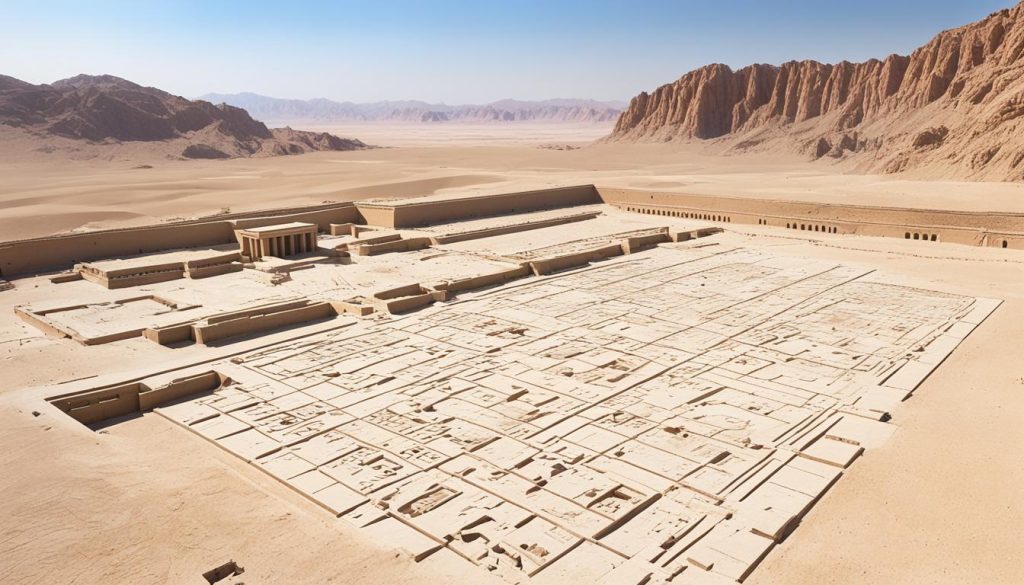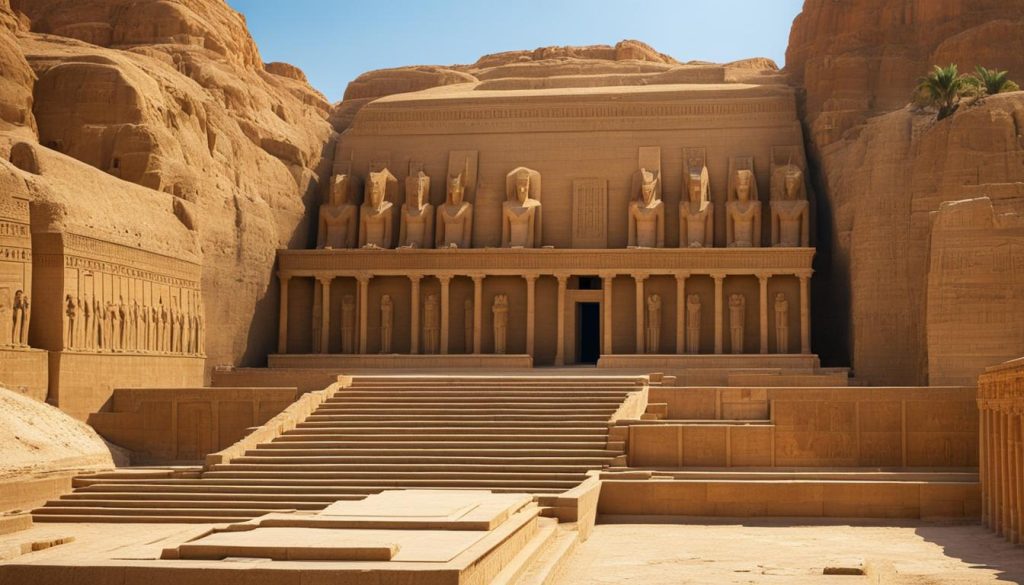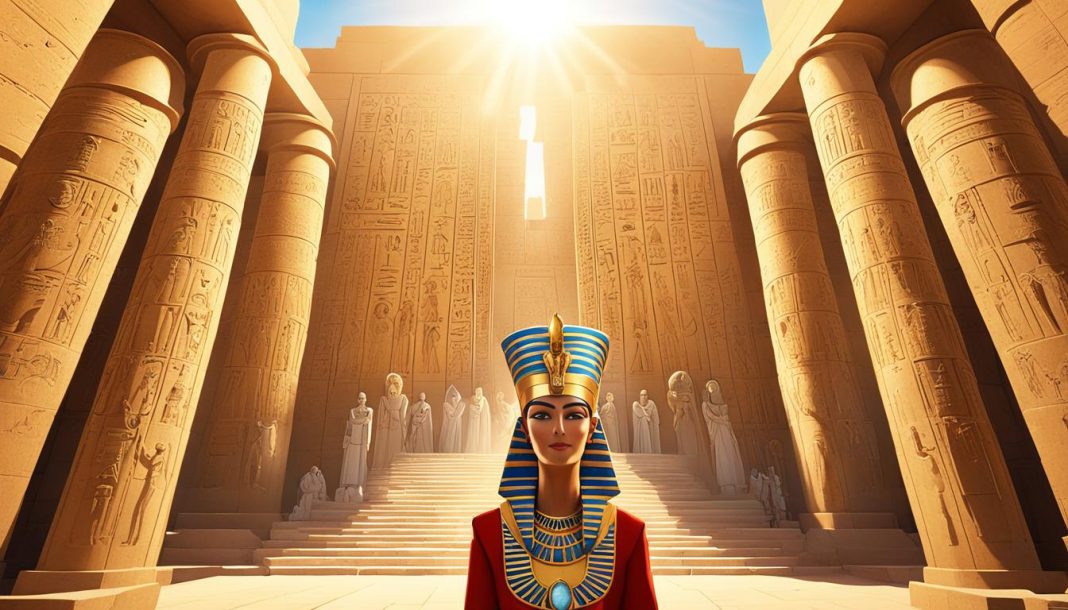Have you ever wondered who the most powerful female ruler in Ancient Egypt was? Meet Pharaoh Hatshepsut, a remarkable queen who defied societal norms and left an enduring legacy through her reign. In a time when women were rarely seen in positions of power, Hatshepsut strategically secured her position as pharaoh and ruled alongside her stepson, Thutmose III, for an impressive 22 years. Her reign brought immense wealth and artistry to Egypt, leaving behind awe-inspiring monuments and architectural wonders that continue to fascinate us today.
Key Takeaways:
- Hatshepsut defied societal norms as a female pharaoh in Ancient Egypt.
- She ruled alongside her stepson, Thutmose III, for 22 years.
- Hatshepsut brought wealth to Egypt through successful trading expeditions.
- Her architectural projects, such as the mortuary temple at Deir el-Bahari, showcased her power and influence.
- Hatshepsut’s reign paved the way for future female rulers in Egypt.
Hatshepsut’s Rise to Power
Hatshepsut’s journey to becoming pharaoh began as the daughter of King Thutmose I. After her father’s death, she married her half-brother, Thutmose II, to help him ascend to the throne. However, when Thutmose II passed away, his young son, Thutmose III, became pharaoh, with Hatshepsut as his regent. To solidify her position and protect the throne from potential challengers, Hatshepsut eventually took the role of sole ruler.
Hatshepsut’s Achievements and Influence
Hatshepsut’s rule as a pharaoh of Ancient Egypt brought immense prosperity to the kingdom. One of her notable achievements was her sponsorship of trading expeditions that ventured to the ancient land of Punt, a region rich in resources such as gold, ebony, and incense. These expeditions not only secured significant wealth for Egypt but also established Hatshepsut as a powerful and influential ruler.
Under Hatshepsut’s guidance, these trading missions flourished, allowing Egypt to acquire coveted materials and establish economic dominance in the region. The wealth brought back from Punt not only elevated Egypt’s status among other ancient civilizations but also contributed to the overall prosperity and splendor of Hatshepsut’s reign.
In addition to her achievements in commerce and economics, Hatshepsut also left a lasting impact through her architectural endeavors. Among her notable projects was the construction of the magnificent mortuary temple at Deir el-Bahari. This grand temple, nestled amidst the cliffs of the Theban Necropolis, was dedicated to the goddess Hathor and served as a powerful symbol of Hatshepsut’s divine authority.
The mortuary temple at Deir el-Bahari showcased Hatshepsut’s keen sense of artistry and design. Its unique terraced architecture, incorporating stunning colonnades, depicted the confluence of beauty and power during her reign. The temple’s grandeur and attention to detail exemplified the artistic accomplishments of Ancient Egypt and solidified Hatshepsut’s place in history as an influential ruler.
Hatshepsut’s Artistic Representation
In ancient Egypt, artistic depictions of Pharaoh Hatshepsut often followed the traditional portrayal of male pharaohs. This adherence to established norms aimed to emphasize her authority and legitimacy as a ruler. However, subtle references to her gender were cleverly incorporated into these depictions, allowing for a nuanced representation of Hatshepsut’s identity.
One can observe inscriptions accompanying her images that identified her as the “Daughter of Re” or “His Majesty, Herself,” subtly acknowledging her femininity within the context of her pharaonic power. This intentional blending of masculine and feminine elements in her portrayals not only showcased her command over the throne but also challenged societal expectations regarding gender roles.
Through these artistic representations, Pharaoh Hatshepsut demonstrated her ability to navigate and transcend gender boundaries, redefining notions of power and authority in ancient Egypt.
Hatshepsut’s Controversial Erasure
After the death of Pharaoh Hatshepsut, her stepson Tuthmosis III took over the throne and embarked on a mission to erase her from history. He commanded the removal of her name and image from numerous monuments and inscriptions, aiming to wipe out any trace of her reign. This deliberate act of erasure was largely successful, leaving Hatshepsut’s legacy forgotten for centuries.
It wasn’t until 1903 that archaeologist Howard Carter rediscovered Hatshepsut’s tomb and brought her back to the forefront of Egyptian history. Through careful examination and deciphering of ancient texts, experts pieced together the story of Hatshepsut’s reign and the efforts to erase her existence.
“Tuthmosis III’s systematic erasure of Hatshepsut from history was an attempt to solidify his own legacy and diminish the influence of the female ruler. However, her remarkable achievements and impact on Ancient Egypt can never truly be erased.”
The erasure of Hatshepsut’s history raises questions about the often selective nature of historical narratives. It serves as a reminder that those in power have the ability to rewrite history and shape the way we perceive the past.

Thanks to ongoing research and advancements in Egyptology, Hatshepsut’s contributions have once again come to light, allowing us to appreciate her remarkable reign and the lasting impact she had on Ancient Egypt. Her story serves as a testament to the complexity of history and the importance of preserving diverse narratives.
Hatshepsut’s Temple at Deir el-Bahari
One of Hatshepsut’s most remarkable architectural achievements was the construction of her mortuary temple at Deir el-Bahari, located in Ancient Egypt. This temple, with its distinctive terraced design and breathtaking colonnades, stands as a grand monument commemorating her reign as pharaoh.
The mortuary temple complex at Deir el-Bahari showcased not only the power and influence of Hatshepsut but also her deep reverence for religious beliefs. Within the temple complex, there were shrines dedicated to the goddess Hathor, who was associated with music, joy, and protection. These shrines served as places of worship and further highlighted Hatshepsut’s devotion to the gods.
Hatshepsut’s mortuary temple was also the final resting place for the pharaoh herself. Within the temple’s walls, her burial chamber was intricately designed to honor her legacy and provide a sacred space for her eternal rest. The temple complex served not only as a functional funerary structure but also as a symbol of Hatshepsut’s enduring power and the divine connection she sought to establish.

In the heart of the temple at Deir el-Bahari, visitors can still witness the impressive architecture, exquisite artwork, and the sense of grandeur that once pervaded this sacred space. The terraced design of the temple, with its symmetrical layers ascending towards the sky, evokes a sense of awe and reverence for the pharaoh. The colonnades, adorned with intricate carvings and vibrant paintings, showcase the artistic achievements of the time and the cultural richness of Ancient Egypt.
Today, the mortuary temple at Deir el-Bahari stands as a testament to Hatshepsut’s reign and artistic legacy. Its preservation and ongoing study provide valuable insights into the political and religious aspects of Ancient Egypt during the New Kingdom period. It is a site of historical significance and a testament to the remarkable female ruler who defied convention and left an indelible mark on the history of Ancient Egypt.
Hatshepsut’s Contribution to Egyptian Art and Culture
Hatshepsut’s patronage of the arts and crafts brought about a golden age of creativity in ancient Egypt. As a visionary ruler, Pharaoh Hatshepsut recognized the profound significance of art and culture in shaping a thriving society.
“Art enables us to express our beliefs, values, and aspirations. Through artistic creations, we immortalize our culture and leave a lasting legacy for future generations,” Hatshepsut once proclaimed.
Under her reign, the artisans and craftsmen flourished, producing exquisite works of art that showcased the skill and ingenuity of the period. Hatshepsut passionately supported and commissioned various art forms, including:
Jewelry:
The Pharaoh recognized the allure and symbolism of jewelry as adornments that reflected both personal status and spiritual devotion. She encouraged the creation of intricate and elaborate jewelry, often incorporating precious gemstones, such as lapis lazuli and carnelian. These exquisite pieces adorned the regal figures and were also buried with the deceased as a display of wealth and power.
Pottery:
“Pottery serves as a vessel not only for practical use but also as a canvas to capture the essence of our everyday life and beliefs,”
Hatshepsut once declared.
Under her patronage, the craftsmanship of pottery reached new heights. Skillful artisans produced elaborate vessels and jars adorned with intricate engravings and vibrant colors. These pottery creations served both practical purposes and as visual representations of ancient Egyptian culture and scenes from everyday life.
Metalwork:
Hatshepsut’s commitment to promoting artistry extended to the realm of metalwork. Exquisite sculptures, ornate masks, and ceremonial objects were crafted using various metals, including gold, bronze, and copper. These distinctive metalwork masterpieces, depicting deities, nobles, and significant events, showcased the technological advancements and artistic achievement of the era.
“Art and culture are the soul of a civilization. Through artistic expression, we celebrate our identity, preserve our traditions, and inspire generations to come,” Pharaoh Hatshepsut once eloquently stated.
Hatshepsut’s unwavering support for artists and artisans not only fostered artistic brilliance but also enriched the cultural fabric of ancient Egypt. The artistic creations of her time continue to mesmerize and captivate audiences today, offering a glimpse into the creative splendor that defined her reign.
Hatshepsut’s Legacy and Historical Significance
Hatshepsut’s reign as a female pharaoh left an indelible mark on Egyptian history. Her achievements in trade, art, and architecture solidified her legacy as one of Egypt’s greatest rulers.
“The impact of Hatshepsut’s reign cannot be overstated. She defied societal norms and successfully ruled over ancient Egypt, leaving behind a remarkable legacy that continues to astound historians and archaeologists.”
Her temple at Deir el-Bahari remains a testament to her power and influence. This grand architectural masterpiece showcases her commitment to constructing monumental structures that would stand the test of time in her honor.
Furthermore, Hatshepsut’s reign as a female pharaoh paved the way for future female rulers in Egypt. Although it would be another 1,400 years before another powerful female ruler, Cleopatra, ascended to the throne, Hatshepsut’s remarkable reign demonstrated that women had the capability to lead with strength and wisdom.
The Historical Significance of Hatshepsut
Hatshepsut’s legacy holds immense historical significance. As a female ruler in ancient Egypt, she shattered traditional gender expectations and proved that women were capable of governing with competence and vision. Her reign challenged societal norms and paved the way for future female leaders.
Additionally, Hatshepsut’s architectural achievements, such as her temple at Deir el-Bahari, demonstrate the grandeur and artistic prowess of ancient Egypt. These monumental structures stand as testaments to her reign and serve as invaluable historical artifacts that continue to captivate tourists and scholars alike.
The enduring legacy of Hatshepsut reminds us of the remarkable accomplishments that can be achieved by individuals who dare to challenge conventional norms and embrace their true potential.
Conclusion
Pharaoh Hatshepsut, an influential female ruler in ancient Egypt, continues to captivate us with her remarkable reign and enduring legacy. Her strategic rise to power, defying societal norms, showcases her determination and leadership abilities. Through her achievements in trade, art, and architecture, Hatshepsut brought glory and prosperity to Egypt, leaving behind a rich cultural heritage that still resonates today.
Hatshepsut’s architectural masterpieces, such as the awe-inspiring mortuary temple at Deir el-Bahari, stand as a testament to her grand vision and enduring impact. Her patronage of the arts and crafts elevated Egyptian culture, resulting in exquisite works of jewelry, pottery, and metalwork that embody the artistic spirit of her reign.
Despite attempts to erase her from history, Hatshepsut’s reign and contributions cannot be ignored. She shattered gender expectations, paving the way for future female rulers and leaving an indelible mark on ancient Egypt. The legacy of Pharaoh Hatshepsut, a true trailblazer and exemplar of female power, continues to inspire and fuel our fascination with Ancient Egypt.
























